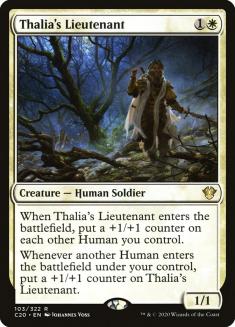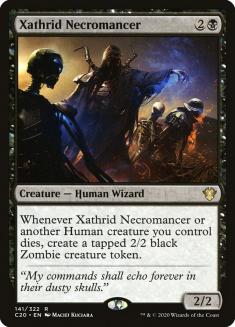It’s easy to underestimate Elspeth, Sun’s Nemesis. Since it only has minus abilities, it may not look like it takes over a game the way a planeswalker should, but don’t let that fool you. There’s a lot of power here if you can take advantage of everything Elspeth has to offer.

Elspeth is definitely an aggressive planeswalker. While the tokens that it makes can technically defend you, if you’re using them to block larger creatures, Elspeth is will just be a mediocre speed bump. This card is definitely leaning completely into the theory that the best defense is a good offense, and you ideally want to be using Elspeth’s -1 ability to push your creatures through larger creatures and force your opponent to chump, trade down, or die.
Elspeth plays best in a medium-wide deck – it wants you to reliably have more than one creature, but if you’re going to have around five or more creatures, you can probably find a better payoff. Think of this as fitting in the kind of decks that would want an Anthem, but not necessarily the kinds of decks that would want an Overrun.
Further, Elspeth plays particularly well with instants and sorceries that make tokens; these cards provide multiple bodies that will benefit from Elspeth’s -1 ability, but they also go directly to your graveyard, where you can ultimately use them to fuel Elspeth’s eventual escape from your graveyard.
I would give minimal consideration to Elspeth’s -3 ability, which you’ll essentially only use when you really have to, or if Elspeth is at exactly three loyalty and you want to put it into the graveyard so you can spend six mana to bring it back and use it again that turn – that should happen often enough that the ability comes up a little more than you might expect, but it’s not an especially pertinent consideration for deck construction.
Regarding the escape ability, Elspeth isn’t actually best used as a self-mill payoff. The rate just isn’t high enough for bringing it back for six mana to be your primary plan with the card. You want to play it in a deck that’s intending to cast it for four mana and then use the escape to fuel yourself into a later game than you’re hoping to play. That is to say, the escape should be considered, but it should be a secondary plan, not the primary purpose of the card. It’s good to play a few cards that will definitely go to your graveyard so you can reliably use the escape when you have to, but for the most part, simply playing a game of Magic should give you more than enough fuel if Elspeth is your only escape card.
Note also that because Elspeth grants power and toughness with no additional keywords, Elspeth works best if your creatures have their own keywords. Adding four power worth of lifelink, first strike, or flying is a lot better than adding four power with no keyword, and whether the power has any of those keywords is simply a function of whether the creatures in your deck (specifically the creatures that you target) have those keywords.
Standard has been a difficult format for aggro decks since the printing of Throne of Eldraine, as the addition of Food makes killing the opponent a lot more difficult, and cards like Lovestruck Beast and Wicked Wolf are hard to attack through. It’s bad enough that Mike Sigrist recently referred to Jeskai Fires as “the aggro deck in Standard,” which is not a description I agree with, but it does make a point about the format.
While Elspeth, Sun’s Nemesis can be a powerful support card for a planeswalker deck and plays pretty well in the same kind of decks as Venerated Loxodon, I can’t claim that it will be enough to reinvigorate white aggro in Standard without considerable additional help from Theros: Beyond Death.
With a larger available card pool and better supporting synergies, I think Elspeth, Sun’s Nemesis could find a few possible homes in Pioneer.
The first point that stands out to me in Pioneer is that Elspeth makes Human tokens. Human tokens are particularly valuable because of their interactions with these two cards:
Building to maximize the synergies with those to cards leads me to a deck like this:
Creatures (26)
- 4 Cartel Aristocrat
- 4 Xathrid Necromancer
- 4 Bloodsoaked Champion
- 4 Zulaport Cutthroat
- 4 Thraben Inspector
- 4 Thalia's Lieutenant
- 2 Giant Killer
Planeswalkers (3)
Lands (24)
Spells (7)

This aggressively slanted Human aggro deck looks to get the opponent to a low life total by attacking and then finish them off with Zulaport Cutthroat. Rally for the Throne and Elspeth, Sun’s Nemesis both make Human tokens, which means that each of these tokens trigger Thalia’s Lieutenant when they enter the battlefield and Xathrid Necromancer when they die. The combination of Elspeth with Zulaport Cutthroat is already a lot to fight through, but when the four tokens Elspeth creates over two turns become eight tokes thanks to Xathrid Necromancer, it can easily become overwhelming.
Radiant Destiny and Obelisk of Urd further take advantage of going wide with all these tokens by making them considerably higher impact, supplementing Thalia’s Lieutenant, which can do that if cast later in the game.
Because Zulaport Cutthroat provides reach in the late-game, I don’t believe this deck requires removal to get through opposing blockers. You’ll usually be able to pump your creatures up enough to get through, but if you can’t, you can win just by chump attacking. As a result, I don’t believe that removal is a high priority for the deck, so I’ve chosen to basically skip it in the maindeck, informed particularly by the fact that, at the moment, there are a lot of combo decks in Pioneer that removal is very bad against. In my experience, Thoughtseize is a better interactive spell than Fatal Push at the moment, but with a deck that’s leaning this strongly on synergies, I’d only want Thoughtseize in matchups where it’s really needed, so I chose to relegate both to the sideboard here.
You certainly don’t have to focus on the tribal aspect of Elspeth, Sun’s Nemesis. Here’s a Pioneer take on Selesnya Tokens that takes advantage of the diversity of planeswalkers that create tokens available in Pioneer:
Creatures (10)
Planeswalkers (13)
- 1 Elspeth, Sun's Champion
- 3 Gideon, Ally of Zendikar
- 4 Nissa, Voice of Zendikar
- 1 Huatli, Radiant Champion
- 1 Ajani, the Greathearted
- 3 Elspeth, Sun's Nemesis
Lands (23)
Spells (14)

This deck plays a little like the Standard Selesnya Tokens deck with Gideon, Ally of Zendikar and Nissa, Voice of Zendikar, except that instead of Archangel Avacyn, we have Divine Visitation to take to the sky, with a wider assortment of planeswalkers, since it’s easier to overwhelm an opponent with tokens when you have several different planeswalkers contributing.
Here’s something of a mashup of those two decks with a new twist: Knights!
Creatures (25)
- 4 Knight of the White Orchid
- 1 Kytheon, Hero of Akros
- 4 Thalia's Lieutenant
- 4 Dauntless Bodyguard
- 4 Venerable Knight
- 4 Worthy Knight
- 4 Acclaimed Contender
Planeswalkers (6)
Lands (23)
Spells (6)

Worthy Knight and friends play extremely well with Thalia’s Lieutenant; which plays well with Elspeth, Sun’s Nemesis; which plays well with The Circle of Loyalty (The Circle of Loyalty makes Elspeth’s tokens bigger, and Elspeth triggers The Circle of Loyalty’s ability to create a Knight when you cast a legendary spell).
This kind of straightforward aggro deck that has go-wide elements without leaning on them exclusively is the perfect natural home for Elspeth, Sun’s Nemesis, which is a great addition to this deck that I’d previously felt compelled to splash another color into to get enough power. The additional planeswalkers could be just what this deck needed.
Somewhere in the process of building the Selesnya deck I was struck with the idea of building an Abzan deck that uses Kethis, the Hidden Hand as intended, rather than purely as a combo enabler. Here’s a deck that’s maybe pushing that a little too far, but it looks very fun:
Creatures (19)
- 4 Knight of the White Orchid
- 1 Anafenza, the Foremost
- 2 Kytheon, Hero of Akros
- 1 Ayli, Eternal Pilgrim
- 1 Thalia, Heretic Cathar
- 2 Oviya Pashiri, Sage Lifecrafter
- 1 Shalai, Voice of Plenty
- 2 Emmara, Soul of the Accord
- 1 Trostani Discordant
- 3 Kethis, the Hidden Hand
- 1 Kenrith, the Returned King
Planeswalkers (5)
- 1 Elspeth, Sun's Champion
- 1 Gideon, Ally of Zendikar
- 1 Vraska, Golgari Queen
- 1 Garruk, Cursed Huntsman
- 1 Elspeth, Sun's Nemesis
Lands (22)
Spells (14)

How can you not get excited about the possibility of casting Primevals’ Glorious Rebirth?
There’s a lot to explore here. This particular build is focused on using Kethis primarily for its body and cost reduction, threatening to get marginal value off the activated ability in the late-game, but you could easily push it further by replacing Knight of the White Orchid with Satyr Wayfinder and adding Grisly Salvage, which would incidentally also help the escape ability on Elspeth, Sun’s Nemesis.
The sideboard doesn’t have to stick this strongly to legendary spells, but it’s both more fun this way and helps call attention to other considerations for the maindeck.
This deck uses Elspeth very differently from the previous deck – where that deck was a perfect fit strategically, this definitely isn’t – it’s just looking for a variety of planeswalkers and Elspeth fits the bill.
Finally, I’d mentioned that Elspeth plays well with instants and sorceries that make tokens to fill the graveyard, so I’d like to look at what happens if we lean into that further:
Creatures (4)
Planeswalkers (8)
Lands (23)
Spells (25)
- 2 Raise the Alarm
- 4 Opt
- 4 Dig Through Time
- 2 Secure the Wastes
- 4 Censor
- 2 Legion's Landing
- 3 Sinister Sabotage
- 2 Divine Visitation
- 2 Rally for the Throne
Sideboard

I’m not sure if this strategy works without a card like Jeskai Ascendancy to get more value out of the tokens. I think Jeskai with Jeskai Ascendancy is the natural home for a deck based on spells that make tokens and delve card draw spells in Pioneer, and I don’t think such a deck is interested in Elspeth, Sun’s Nemesis because I think Heroic Reinforcements and Stoke the Flames are the only four-mana spells that deck would be interested in.
I think Azorius gets considerably better mana than Jeskai and you can play a pretty good flash game. I just worry that the tokens might not pull their weight against the creatures that are played in Pioneer. Elspeth, Sun’s Nemesis; Gideon, Ally of Zendikar; and Divine Visitation are all present to attempt to help with that, and I’m very interested in putting a lot of counters on Dovin, Grand Arbiter, but I definitely have my reservations about this strategy.
After evaluating the possibilities and looking at the sorts of decks that might play Elspeth, Sun’s Nemesis, it should come as no real surprise that Elspeth looks to fit best in a fairly traditional aggressive white deck as a split Anthem/token generator (which is a great pair of effects to split!). Given that the previewed Athreos showcases the return of the devotion mechanic, I expect that we should expect Elspeth to show up primarily or exclusively in mono-white decks in Standard. Maybe the draws in Theros: Beyond Death to play only a single color will be sufficient to change the landscape of Standard to support monocolored strategies, which, despite the support for those decks present in Throne of Eldraine Limited, hasn’t really made its way into Standard yet.


